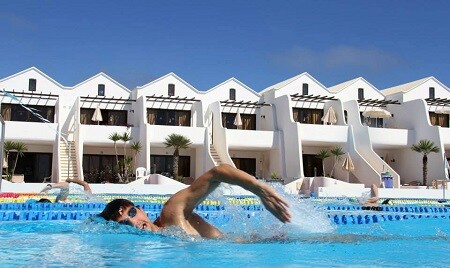How to improve the efficiency in swimming?

With these tips you will make the most of the energy you use in the water
When we talk about improving in the swimming segment and getting the best performance in it through our training, we are really talking about "Be more efficient in the water" According to the Dictionary of the Royal Spanish Academy, efficiency (from Latin efficientĭa) is 'the relationship between useful energy and inverted energy'. At the same time, we should not confuse it effectively, which is defined as 'the ability to achieve the desired or expected effect'.
Our collaborator Personal Running He tells us through this article that he has some advice, all of them aimed at achieving greater efficiency in our swimming, that is, making the most of the energy we use in the water, and not misusing it. lead to fatigue and not reach the swim speed we want.
BODY POSITION
We should always work on a position as hydrodynamic as possible, that is, flat and parallel to the surface of the water. A very common mistake is to swim with your head too raised. That makes the trunk and legs descend and therefore we offer a greater resistance to the advance.
This makes us inefficient. To avoid this, we should start swimming with our head more sunken, moving it the only thing necessary to breathe, taking the look more diagonally than frontally. This would automatically raise the hips and also the legs, offering less resistance to advance.
THE ROLIDO
The rotation on our longitudinal axis is key to achieve greater efficiency. In general, we swim too flat, that is, we do not take advantage of the rotating movement of the body to reach further with the stroke and apply more force in its underwater phases.
We do not help ourselves from the body as we should and try to pull only with our arms, wasting our energies abusing these muscle groups and therefore reducing efficiency. It would be wise to do a lot of deadlock work, insisting that rotation to allow moving forward in a more rectilinear way, helping the whole body to exert force so that you can reach further with the hand that slides forward and end better with the accelerating May.
THE SUPPORTS
Failure to perform the correct supports supposes a limitation in the work on our important efficiency. Therefore, it is key to work on the perception and awareness of the hand in the various supports and underwater trajectories of the same. If the hand does not support well, it descends and allows the elbow to fall, which breaks the correct position of the arm in its intention to catch water and move it backwards and ultimately makes our stroke inefficient. It is therefore important to know where we rely and how to achieve an efficient swim, always trying to look for "dead" or "solid" water.
SYMMETRY IN THE NADO
It is common to see how one hand gets too crossed or too open with respect to the other, or even one member exerts a greater force on the water than the other. It would be necessary to work on it to equalize said muscular actions, thus enhancing the weak, distributing and dividing equally the energies, avoiding that some become overloaded, saturated or reach fatigue before the others.
CONTROL AND FLUIDITY
The aquatic environment has a "sensor" that immediately captures everything that represents tension, rigidity, seizure, abruptness, etc ... To be more efficient, it is essential that our movements in the water are fluid, harmonious, clean and controlled. We should not fight against water, but be part of it. Understand it to be able to lean on it to slide forward. Except in short and explosive tests where the technique goes to the background, we must save all possible energy in the advance, coordinating all our muscle groups for it in a rhythmic and synchronized way.
These are the tips that from Personal Running Here we leave you, so that you can make your swim a more efficient exercise, and in short, get a greater performance from it.
In our blog you will find a series of videos that will help you to work all that we have mentioned before.
http://personalrunning.com/web/tecnicas-de-natacion/
There are no previous results.




























